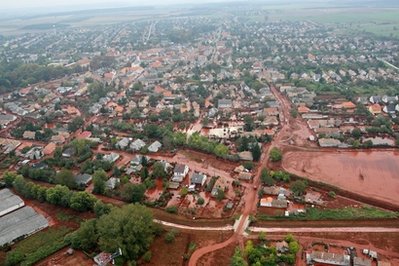 Dead fish are floating in the Danube after a toxic sludge spill that killed four people in Hungary reached Europe’s second longest river.
Dead fish are floating in the Danube after a toxic sludge spill that killed four people in Hungary reached Europe’s second longest river.
Blood-red sludge reached the main branch of the Danube after wiping out all life in the smaller Marcal tributary, said the regional chief of Hungary’s disaster relief services, Tibor Dobson.
“I can confirm that we have seen sporadic losses of fish in the main branch of the Danube,” he said.
“The fish have been sighted at the confluence of the Raba with the Danube,” where water samples had shown a pH value of 9.1, he said.
“In order to save the river’s ecosystem, the pH level must be brought down below 8,” Mr Dobson added.
Water alkalinity is a measure of river contamination and on a scale of 1-14, pH values of 1-6 are acid, between 6 and 8 are neutral, and readings of 8-14 are alkaline.
Mr Dobson said that pH values of 9.6 had been measured in the Raba, a tributary of the Danube, up from earlier in the day, and 9.4 in the Danube’s Mosoni branch.
In the village of Gyirmot, where the Marcal flows into the Raba, volunteers collected bucketfuls of dead fish from the stinking water, which was covered in a slimy film of grey bubbles caused by gypsum, which was pumped in to reduce alkalinity.
The toxic spill poured from a reservoir at an aluminium plant in Ajka, 160 kilometres west of Budapest, which burst on Monday, sending 1.1 million cubic metres of red sludge into surrounding villages.
Four people died in one of the villages, Kolontar, from where the tiny Torna stream flows into the Marcal.
The Marcal is a tributary of the Raba, which in turn flows into the Danube, that runs from Hungary through Croatia, Serbia, Bulgaria, Romania and Ukraine before reaching the Black Sea.
International Commission for the Protection of the Danube executive director Philip Weller says while there has been significant efforts to minimise the toxicity of the sludge, the Danube will need to be closely monitored for some time.
“It is clear it is not going to have the kinds of dramatic health effects that could have been the case in the Danube because of the dilution effects that were perhaps anticipated or potentially anticipated at the outset,” he said.
“Hungarian authorities have done a significant amount of work to try to minimise that.
“We will need to continue to monitor the situation. That is being done to determine if it really is a case that we can indicate that it is, I won’t say a good situation, but certainly a lot better than it could have been.”
Hungarian prime minister Viktor Orban described the spill as a serious ecological catastrophe when he visited the village of Kolontar where the disaster began.
“What I have seen is terrible, simply terrible. This is the first tragedy here in Hungary,” Mr Orban said.
“People are desperate. There is no trust at all.
“Two weeks ago there was some control procedure. The official report said that everything is OK and you can see how, what does it mean OK?”
While the clean-up of dead wildlife continues, concern is now growing about the health dangers posed by the sludge after it dries out.
Secretary of state for the environment Dr Zoltan Illes says it could become toxic dust.
“If it were to dry out then it will be too late, because if that is dry then wind can blow it away and this is heavy metal contamination inside,” Dr Illes said.
“Which… if I breathe it that will cause damage to my lungs.”
Hungarian authorities have launched a criminal inquiry into the incident.



